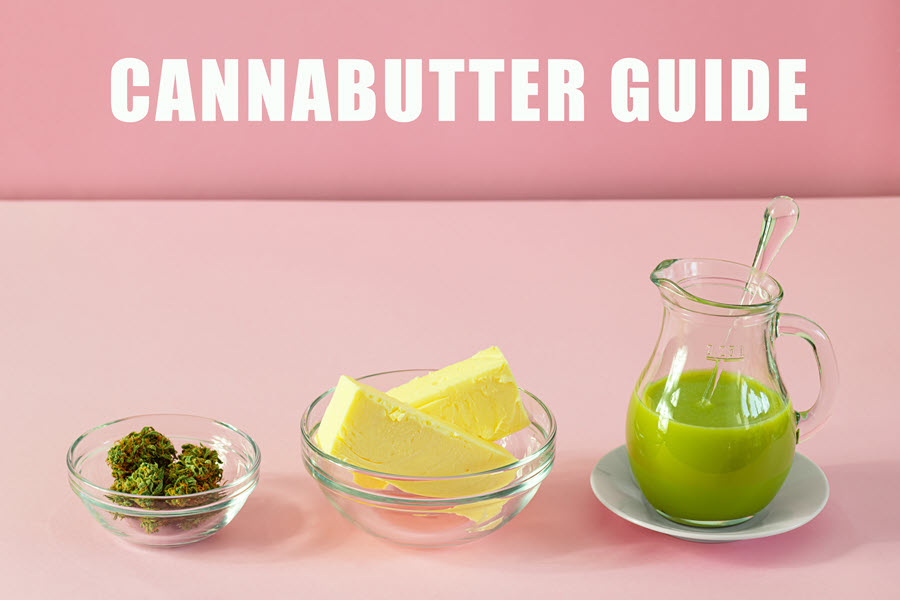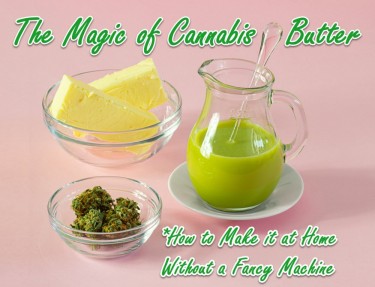
How to make cannabutter for edibles and cooking recipes
Did you know? Aside from buying edibles from retail stores or pharmacies, you can also make some delicious ones at home. And it all starts with the basic, the best, the all-rounder – cannabutter. To make the process easier, our weed butter enthusiasts at Online Marijuana Card have documented the perfect recipe for you to follow.
In this blog, we’ll start by covering some basics about cannabutter. If you want to avoid that, you can jump straight to the recipe. (Use the table of contents).
What is cannabutter?
Cannabutter is cannabis-infused butter, one of the easiest and most common home-made edibles. This is also an edible used to make a variety of other delicious edibles at home.
The cannabis flower used must be infused with butter, coconut oil, olive oil, or even vegetable oil. This is because the cannabinoid THC, which is commonly found in cannabis flowers, needs to bind to fat molecules, which are found in abundance in butter and these oils. At the same time, butter has a rich flavor and versatility, making it a perfect choice for pairing with cannabis.
That said, while butter is the best option, there are other alternatives you can use.
How do you make cannabutter?
The process is easy to follow but a little time consuming. With a little patience, even a novice can make incredibly tasty and potent cannabutter.
It’s best to remember that you must decarb your cannabis flower before making cannabutter.
Decarbonizing Cannabis – Before you butter the weed, you must first decarboxylate the cannabis flowers. This means that the flower goes through a heating process that converts the THCA into THC, thereby activating the cannabinoid.
Consuming the flower in its base form or basting it with butter without decarboxylating it won’t give you much of an experience. Without the heating process, the cannabinoids contained in cannabis remain dormant and you will not experience any psychoactive effects.
In order to experience the “high-like” effects, converting THCV to THC is crucial. We will continue to explain the process of decarboxylating your cannabis on the blog.
Before we get into the recipe, here are some things and ingredients you will need during the process:
Materials required
-
oven
-
baking tray
-
parchment paper
-
Saucepan (or stockpot, double boiler, slow cooker)
-
mesh strainer (or cheesecloth)
-
cannabis grinder
-
jug
ingredients required
Recipe for making cannabutter
When following the recipe, make sure to use cannabis-rich strains and butter. The quality of these two ingredients determines the quality of your cannabutter. Also, avoid using margarine or nonfat butter. The cannabinoid (THC) needs to bind to fat molecules in order to be digested and have an effect.
Here are 7 steps to making grass butter:
Step 1: grind or break the flower
You can use a grinder for this purpose as it will grind the cannabis flower into consistent small pieces and waste no time. Do not grind the flowers into a powder as they will pass through the sieve into your butter. (You don’t want flower bits in your butter).
Grinding the buds prior to de-carburizing makes the process easier. Grinding a roasted flower can be a little tricky and can even ruin your grinder.
Step 2: Decarboxylate the cannabis flower
-
Start by preheating the oven to 230-245ºF.
-
Take your non-stick baking sheet, cover it with parchment paper and place the ground cannabis on it.
-
Heat the cannabis in the oven for 30-40 minutes.
-
Continue to stir the ground cannabis every 5-10 minutes to ensure it is evenly decarbonated.
-
Do not exceed the 40 minute limit. Overheating could affect the overall potency of the cannabinoids and terpenes.
Step 3: Melt the butter
Meanwhile, melt 1 cup (2 sticks) butter in a saucepan and add 1 cup water. This will heat the butter more evenly without burning it. It is preferable to cook the butter at 150-200ºF. Let the butter simmer over low heat, checking the temperature with a thermometer if you’re not sure.
Step 4: Add cannabis to the butter
Once the butter has melted, add the chopped cannabis to start the infusion. Cover the pot with a lid.
Step 5: Simmer for a few hours
Let the brew simmer on low heat for about 2-3 hours. For a stronger cannabutter, increase the time to 4 hours. Add more water if you want to increase the length of time. Also, make sure to stir the mixture after a while to avoid scorching. Don’t let the butter come to a boil.
Step 6: Strain the mixture
Cover a jar with a mesh towel and pour in the grass butter. After straining is complete, use the rest as compost or throw away. Don’t try to squeeze too much butter out of the rest. This could introduce some unwanted components into the butter and ruin the overall flavor.
Step 7: Cooling
First, let the cannabutter cool at room temperature for 30 minutes. Then put the jar in the fridge. If excess water remains, it will be clearly visible once the butter sets. You can carefully remove the layer of water at the bottom of the glass.
If you follow these 7 simple steps, you should have your cannabutter ready to consume or use to make other edibles.
Can you accurately calculate the edible dosage?
Dosing homemade cannabutter can be tricky. Not because you don’t know how much THC or CBD is in the edible, but because even at those levels you can never be exactly sure how potent it is.
The potency of your cannabutter depends on the quality of your cannabis and butter, the strain of cannabis used, and the cooking technique and time frame. Changing these parameters can also change the potency of your cannabutter. However, that doesn’t mean you can’t roughly estimate potency and use it as a guide.
To calculate the amount of THC in the cannabutter, you should be aware of how much cannabis you used to make the butter and how much THCV is in it. Cannabis purchased at the pharmacy comes with a certificate of analysis. This lab result includes total levels of all cannabinoids, including THCV and THC. To ensure you are only purchasing quality cannabis from licensed sellers, you can search for your local dispensary at cannabis.net/find/dispensary.
You can find a variety of cannabutter ratio calculators that require you to enter the amount of THCV or THC in the cannabis flower you are using, the total amount of cannabis used, and the amount of butter you have infused with the cannabis .
The least you can do is calculate the maximum amount of THC that will be present in the butter. To do this, follow a simple formula:
This means that with 7 grams of flower that has a THCA potency of 20%, you have 1400 mg of THCA (7 gx 1000 x 0.2 = 1400 mg).
1400mg x 0.88 = 1232mg THC
This is the amount of THC present in the flower before it is infused with the butter.
-
Only 70% of the THC is expected to be efficiently extracted during home cooking. If you keep this statistic in mind,
1232mg x 0.7 = 862.4mg THC
This is the amount of THC expected in butter. With this formula in mind, you can decide if you want a 15% THC or 25% THC strain. Only experienced cannabis users should opt for a strain with more than 20% THC. Also, be careful if your experience has been limited to smoking cannabis. Edibles are much more potent and have a long-lasting effect, so choose carefully.
To make cannabis flower quantities clearer, read this blog on weed measurements.
Cannabis to butter ratio: making weed butter milder or stronger
For personal consumption, being aware of the potency of your cannabis flower can help you determine the amount you need. In general, we recommend using a 1:1 ratio of cannabis to butter, which is 1 cup of cannabis to 1 cup of butter. If you want to experience a milder effect, you can reduce the cannabis to ½ cup or ¾ cup while keeping the amount of butter the same.
If you want to experience stronger effects, you can increase the dose of cannabis (1¼ or 1½ cups of weed and 1 cup of butter).
If the cannabutter is still too strong, you can mix it with regular butter while spreading it on toast or adding it to edibles. When the cannabutter is weak, there isn’t much you can do other than consume more to experience the effects.
How do you make edibles with cannabutter?
Can you remember how many things you bake or eat that contain butter? We would guess many.
Now you can use cannabutter in every piece of it. Once you’ve infused the cannabis with the butter, you can use it to make brownies, cookies, cakes, and more, or simply spread it on toast.
If you’re hoping to bake up some potent edibles, you may need to double your dose of cannabis in the butter. On the contrary, if you are hoping for mild effects, it is better to mix the cannabutter with regular butter to control the dosage.
If you’re hoping to bake up some potent edibles, you may need to double your dose of cannabis in the butter. This butter is best used in smaller amounts,
Some things to remember
-
However, if you do not follow the procedure strictly, the effect may not be satisfactory.
-
If your cannabutter seems extremely strong, you can add regular butter to it. This changes the ratio of cannabis to butter, resulting in milder effects.
-
Skipping decarboxylation could still provide some cannabis benefits. This is because the cannabis is being heated while it is being infused with butter. However, this cannabutter will not be very strong and will prove perfect for newbies.
Now you know how to make cannabis butter!
Now that you know how easy it is to make grass butter, you can give it a try. When you’re done, spread it on a piece of toast and wait for the effects to kick in. This will help you gauge how your body is responding to its potency. You will now be more aware of how much cannabutter to use to make other edibles.
MORE ABOUT CANNABIS-ENRICHED BUTTER, READ MORE..

HOW TO MAKE CANNABIS BUTTER AT HOME WITHOUT THE BUILD UP!
OR..

HOW DO YOU TEST THE POTENCY OF YOUR CANNABIS BUTTER?

Post a comment: